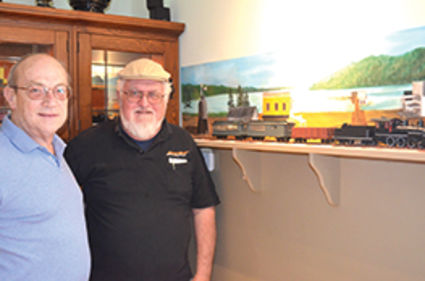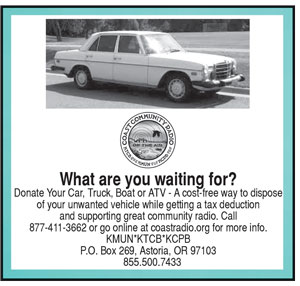Columbia's past comes to life with miniature train
April 16, 2014

Former Mayor Dick Swart and his wife Dixie live in a house on the hill. They used to have three normal cats and an odd one named George. George lived to the ripe old age of 26 and would proudly preen while his veterinarian paraded students past the perfect specimen of Felis Catus.
But this story isn’t about George. It’s about a love for trains and friends and history and art.
The house was built in the mid-thirties, this much they know. They have a copy of the building plans, but it can’t be authenticated. To top it off, the Swarts have been given conflicting information.
In the house is a room. It was fashioned out of the view of the neighbor’s home, a simple addition to the first floor for residents who were growing less fond of ascending stairs.
“We were deciding whether to stay in Cathlamet at the time,” Swart said. “We considered buying another house. We loved it here but we needed more space on the ground floor. So we added a 16 x 20 foot extension for a multipurpose room. Now it’s an office for Dixie who is working on a book on Chatham family history. There’s a desk for my activities. Plus big comfortable chairs to relax in while we watch television or listen to music.”
“There is space for my railroad book collection and some model trains,” Dick added. And lights and whistles and other fancy parts from old trains.
Dick Swart has built several models of train cars, more exacting than directions often call for. Sentiment--a memory or a story of a ride in a train is what draws him to certain models.
Focus in to the narrow shelf built around the room, the length of three walls. It has a track. And on that track runs a train.
This is where friends and history and art come into the story.
Dixie decided that this train needed something. She commissioned friend and local artist David Goodroe to paint a mural the length of the track for Dick’s birthday.
“He’s a real artist,” Dixie said proudly, accent heavy on “real.”
Goodroe fashioned a kind of scroll in order to paint on a narrow 43 foot long canvas in three foot sections. Though he prefers oils, they take too long to dry so he opted for acrylic paint.
“I worked on it at home and then I would come here and put it up” Goodroe said. “We’ve had to do some tweaking. It’s a work in progress.”
According to Swart, the mural is a depiction of what used to be called the Clam Shell Railroad that the Ilwaco Railway and Navigation Company used to run from Megler to Nahcotta, through Long Beach and Ilwaco.
The mural is based on the limited information and pictures that they could find from source material. Swart said that he searched Appelo Archives and sought advice from local historians. One told him that there wasn’t much, but hope remained that an old trunk might be found in an attic or a relative of someone who was in the Coastal Defense Corps might find something.
“It’s as historically accurate as we could get it. The books are pretty spotty,” Goodroe said.
Swart agreed.
“There is limited fruit to be plucked from the local museums,” he said.
“The time period is roughly 1915 before a number of buildings burned,” Swart continued. “I’m stretching the time period a little bit so that I can use my favorite locomotive that came after that date. But, you know,” he smiled, “it’s my house.”
“This is a narrow gauge passenger train,” Dick said. “The track gauge on the Clam Shell Railroad was three feet, a standard narrow gauge economy version of railroading in the US in the late 19th and early 20th century. The locomotive for that era and gauge was pretty big and heavy. It was the end of the technology for small locomotives.”
According to Goodroe, the train was designed to move logs from Nahcotta to Astoria and to transport tourists to favorite spots along the peninsula.
“Tourists would take the boat from Portland to Astoria or Ilwaco,” Swart said. “You could take the ferry over to Megler. It was a very seasonal business. In the summer, the locomotive moved long passenger trains. In the fall and spring it would combine freight and passenger trains. During the school year, an extra coach might be added for students to travel back and forth.”
The mural is the scene you would see if you were riding the train and looking eastward. Goodroe depicts the church and town of Megler, Fort Columbia, Black Lake and a cranberry bog. He has added a cranberry exchange building.
It includes the Portland Hotel and the town of Nahcotta. The hotel and the town burned down in 1915.
They had to use a little creative license in the choice of colors for the buildings but Swart discovered that barn red, whitewash and ochre were common colors during that time and they went from there.
Swart plans to build half of a ferry terminal at Megler with a waiting room and “vagrants hanging out.” He has also been looking at pictures of existing mills in order to create a corner of industry with a three dimensional structure.
Goodroe has been adding details and peopling the scenes.
One town has a grocery store and a restaurant. It also has a red light district that mostly exists in the minds of its fun loving creators.
“We had to add some racy people in there,” Goodroe laughed.
“But no red lanterns or naked legs dangling out the window,” Swart said. “The fellows at the pool hall or the hotel knew where to go.”
They know the hotel needs a cat, and they know it needs to be visible but they still aren’t sure what the cat would look like.
It should probably look like a 26 year old wonder cat named George, memorialized like the Clam Shell Railroad which disappeared with the advent of local highways in 1930.
They have plenty of time to decide and lots to do while they are thinking about it. They are having so much fun it could turn into a long term project.












Reader Comments(0)